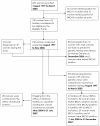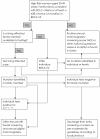Eligibility for magnetic resonance imaging screening in the United Kingdom: effect of strict selection criteria and anonymous DNA testing on breast cancer incidence in the MARIBS Study
- PMID: 19567506
- PMCID: PMC2869031
- DOI: 10.1158/1055-9965.EPI-09-0138
Eligibility for magnetic resonance imaging screening in the United Kingdom: effect of strict selection criteria and anonymous DNA testing on breast cancer incidence in the MARIBS Study
Abstract
Introduction: A UK multicenter study compared the performance of contrast enhanced-magnetic resonance imaging with X-Ray Mammography in women at high-risk of breast cancer commencing in 1997. Selection criteria were used to identify women with at least 0.9% annual risk of breast cancer.
Methods: Women at high breast cancer risk, with a strong family history and/or high probability of a BRCA1/BRCA2/TP53 mutation, were recruited from 22 centers. Those not known as gene carriers were asked to give a blood sample, which was tested anonymously for mutations. Women ages 35 to 49 years were offered annual screening for 2 to 7 years. Study eligibility at entry was assessed retrospectively by detailed examination of pedigrees and overall eligibility accounting for computer risk assessment and mutation results.
Results: Seventy-eight of 837 (9%) women entered for screening were ineligible using the strict entry criteria. Thirty-nine cancers were detected in 1,869 women-years in study (incidence 21 per 1,000). Including 3,561 further years follow-up, 28 more breast cancers were identified (12 of 1,000). Incidence rates for 759 eligible women were 22 of 1,000 in study and 13 of 1,000 in total follow-up, compared with 9 of 1,000 and 4 of 1,000, respectively, in 78 ineligible women. Breast cancer rates were higher for BRCA2 than BRCA1 after testing anonymized samples in this selected population at 65 of 1,000 in study and 36 of 1,000 in total follow-up for BRCA2 compared with 44 of 1,000 and 27 of 1,000 for BRCA1.
Conclusions: Strict enforcement of study criteria would have minimally improved the power of the study, whereas testing for BRCA1/2 in advance would have substantially increased the detection rates.
Figures



References
-
- Leach MO, Boggis CR, Dixon AK, et al. Screening with magnetic resonance imaging and mammography of a UK population at high familial risk of breast cancer: a prospective multicentre cohort study (MARIBS) Lancet. 2005;365:1769–78. - PubMed
-
- Kriege M, Brekelmans CT, Boetes C, et al. Efficacy of MRI and mammography for breast-cancer screening in women with a familial or genetic predisposition. N Engl J Med. 2004;351:427–437. - PubMed
-
- Warner E, Plewes DB, Hill KA, et al. Surveillance of BRCA1 and BRCA2 mutation carriers with magnetic resonance imaging, ultrasound, mammography, and clinical breast examination. JAMA. 2004;292(11):1317–25. - PubMed
-
- Kuhl CK, Schrading S, Leutner CC, et al. Mammography, breast ultrasound, and magnetic resonance imaging for surveillance of women at high familial risk for breast cancer. J Clin Oncol. 2005;23:8469–76. - PubMed
-
- Hagen AI, Kvistad KA, Maehle L, et al. Sensitivity of MRI versus conventional screening in the diagnosis of BRCA-associated breast cancer in a national prospective series. Breast. 2007;16:367–74. - PubMed
Publication types
MeSH terms
Substances
Grants and funding
LinkOut - more resources
Full Text Sources
Medical
Research Materials
Miscellaneous

